Suchergebnisse
BIM2BEM Flow - Continuous BIM-based energy efficient planning
Automated integration and assignment of exchange requirements between the design and simulation programs, based on the elaborated exchange information requirements, should enable continuous energy efficiency planning along the design phase.
Conference: 8th A3PS Conference: Eco-Mobility 2013
3. - 4. October 2013
Tech Gate Vienna, Donau-City-Straße 11220 Vienna, AT
Strategies, R&D-Funding Programs and Projects of Industry, Research and Public Authorities for the Development and Market Introduction of Alternative Propulsion Systems and Fuels.
12th Heat Pump Conference: Rethink Energy, Act NOW!
15. - 18. May 2017
World Trade CentreRotterdam, NL
A conference where the latest development and prospects in technology, applications and markets are shared with applied professionals.
Workshop: Green ICT for Growth and Sustainability
1. June 2012
Vienna University of Econonomics and Business
Vienna, AT
The event brings together high-level scientists and policy-makers to explore, discuss and address pressing questions on the potentials and challenges of Green ICT for Economic Growth and Sustainable Consumption.
IEA: Co-utilisation of Biomass with Fossil Fuels

Summary and Conclusions from the IEA Bioenergy ExCo 55 Workshop
Englisch
Smart Grids Showcase Region: Salzburg
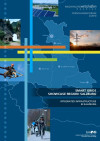
Integratred Infrastructure in Salzburg
Forschungsforum
2/2010
Herausgeber: BMVIT
Englisch, 6 Seiten
Downloads zur Publikation
Policy Guidelines for Electric Motor Systems (2014)
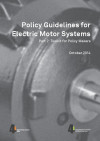
Diese Policy Guidelines enthalten die Beschreibung eines Motor Policy Toolkits bestehend aus sieben Politiken: Mindeststandards, Labelling, Freiwillige Vereinbarungen mit der Industrie, Energiemanagement Programme, Energieauditprogramme, Unternehmensmotorpolitik, finanzielle Anreize und Bewusstseinsbildung.
K. Kulterer, P. Lackner, R. Werle, C. U. Brunner, M. Ellis
Herausgeber: IEA-4E Electric Motor Systems Annex
Englisch, 64 Seiten
Downloads zur Publikation
Policy Guidelines for Electric Motor Systems (2013)

Dieser Beitrag für die EEMODS Konferenz 2013, beinhaltet einen Bericht zum Zwischenstand der Erarbeitung der Policy Guidelines for Electric Motor Systems. Er gibt einen Überblick über verpflichtende Motorpolitiken und führt im Detail die Empfehlungen bei der Einführung von Mindeststandards für E-Motoren aus und beschreibt freiwillige Motorpolitiken (Labeling, Energiemanagement, Energieaudits, Tools) mit Beispielen aus den teilnehmenden Staaten.
K. Kulterer, P. Lackner, R. Werle
Herausgeber: IEA-4E Electric Motor Systems Annex
Englisch, 9 Seiten
Downloads zur Publikation
Project Synopses Energy Systems, Grids and End-use
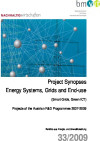
Smart Grids, Green ICT
Projects of the Austrian R&D Programmes 2007-2009
33/2009
Englisch, 42 Seiten
Downloads zur Publikation
Energy Workshop Northern Waldviertel

A local " integrated" energy program - successful implementation through research cooperation
Forschungsforum
1/1996
Herausgeber: BMVIT
Englisch, 6 Seiten
Sustainable hospitals: a socio-ecological approach.
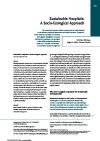
In: GAIA 20/3 (2011), S. 191-198
Weisz, Ulli, Haas, Willi, Pelikan M, Jürgen, Schmied, Hermann
Englisch, 8 Seiten
Downloads zur Publikation
IEA Advanced Fuel Cells Newsletter 07, Winter 2015

Der Newsletter gibt einen Überblick über aktuelle Aktivitäten in den teilnehmenden Ländern sowie in den verschiedenen Annexen.
Herausgeber: IEA Advanced Fuel Cells Implementing Agreement
Englisch
Film DVD Energie 2050 - Aufbruch in ein neues Zeitalter

Mehrsprachig
IEA-SHC Newsletter: "Solar Update" Issue 61, May 2015

Herausgeber: IEA- Solar Heating and Cooling Programme
Englisch, 22 Seiten
Downloads zur Publikation
Integrated energy systems
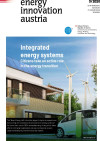
Citizens take an active role in the energy transition
energy innovation austria
3/2020
Herausgeber: BMK in cooperation with the Climate and Energy Fund
Englisch, 12 Seiten
Downloads zur Publikation
Positive energy districts
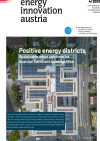
Sustainable urban solutions for Austrian towns and municipalities
energy innovation austria
4/2020
Herausgeber: BMK in cooperation with the Climate and Energy Fund
Englisch, 12 Seiten
Downloads zur Publikation
IEA ISGAN Annex 6: Electricity Transmission and Distribution Systems (working period 2021-2022)
ISGAN Annex 6 deals with the possible system-related challenges in the development of future smart grids. Austria is leading Task 4 Interaction of Transmission and Distribution Networks. The main topic in the work program relates to flexibility topologies within transmission and distribution grids. The results and analyses had been published on the one hand in a discussion paper and in condensed form in a video. Communication and dissemination activities were targeted and conducted to different stakeholder groups.
IEA ISGAN Annex 7: Smart Grid Transitions (Working period 2020-2023)
ISGAN Annex / Working Group 7 explored how Smart Grids can support the energy transition. Focus areas included transition processes, governance, market development, and decentralized actors like prosumers. Results were shared through policy briefs, publications, and workshops. An international Community of Practice connects policymakers from ministries, regulatory agencies, and funding bodies and fosters smarter energy systems.
IEA-ISGAN Working Group 5: Smart Grids International Research Facility Network (SIRFN) (Working period 2021 - 2024)
As a global network, SIRFN works to improve the understanding of smart grid technologies and to promote their development and dissemination worldwide. Austria's participation during the project period ensured the networking and visibility of the Austrian smart grid research infrastructure at a global level and provided important access to a worldwide network of leading institutions and laboratories.
International Passive House Summer School for Students (PH-SS)
Summer school / workshop for design, construction and calculation of buildings in the passive house standard for students from Austrian and European universities.
